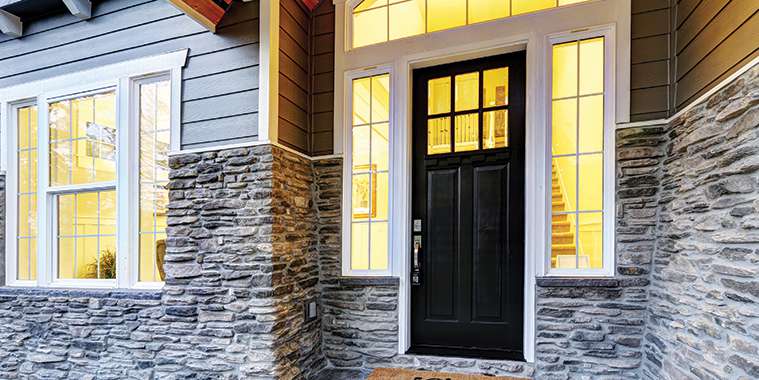Improving your home’s curb appeal brings immediate satisfaction. Plus, the financial benefits can be fabulous, too. Good curb appeal increases your home’s value, making your property easier to sell — and easier to love.
The challenge? Spending too much limits your ROI (return on investment), yet going cheap could cost you more in redos. The key is to choose durable materials that’ll save you money over time while making your house look fab.
Here’s how to make that happen:
1. Non-porous rocks
A gorgeous rock bed is a great way to introduce low-maintenance beauty to your home. But don’t throw just any rocks on the ground.
For example, avoid limestone, which breaks down quickly and will soon become rubble. Instead, choose a non-porous stone like decomposed granite, which costs $100-$300 for a 400 square-foot area, or trap rock, which gives you that classic “rock” look and costs about the same.
When you’re choosing larger individual stones, look for smooth, round ones, which last longer and don’t produce rock dust — the irritating, gritty rock-garden debris beloved by weeds.
Also, if the gravel look is what you’re going for, pea gravel is a great, permeable option — but only in areas without a ton of runoff because its small size makes it easy to wash away.
2. Fiberglass front door
A fiberglass front door doesn’t just look good — it also recoups some of its cost when it’s time to sell. Homeowners spent an average of $2,700 on a fiberglass door and earned back 74% of the cost during the sale, according to the Remodeling Impact Report form the National Association of REALTORS®.
Fiberglass doors offer other benefits, too. Like steel doors, they’re more energy-efficient than standard wooden front doors. But unlike steel doors, they’ll look good for a long time. Fiberglass resists weathering and damage and won’t suffer from ugly dents and rusting.
3. Insulated steel garage door
Wood and steel are the two most common garage door materials. While wood does have an undeniable classic appeal, insulated steel doors, which start at $750, offer the most bang for your buck — and fill up less time with irritating maintenance tasks like repainting or staining.
Plus, a new garage door snags a fantastic 87% return on investment.
Choose steel garage doors with 24- or 25-gauge panels. But don’t go higher — the higher the gauge, the thinner the metal, and you don’t want to go too thin or you’ll compromise durability.
Don’t skip the insulation, either, especially if your garage is attached to your house. Garage door insulation is sandwiched between two layers of steel, helping with durability, as well as saving on energy costs.
4. Concrete or brick edging
Edging transforms your garden from a blah blob of mulch to an intentional, purposeful and beautiful space. And edging does more than look great: When you have a line to follow, mowing and trimming become much simpler.
Edging does a phenomenal job of containing the mulch and keeping it from spilling onto your lawn.
Use concrete or brick edging, which survive the elements better than plastic and offers a more permanent, planned look than cheap weaving around your landscaping.
5. Concrete pavers
In a perfect world, you’ll choose your paver material based on your landscaping and home.
Ideally, the architecture should drive the selection of hardscape materials. Flagstone with foliage joints looks compelling for a traditional home but would be out of place as an approach to a seaside design.
There is a one-size-fits-most solution for pavers, though: concrete. Not only can you find enough sizes, colours and designs to mimic almost any style, but the material is also more durable than brick.
Concrete’s permeability is a big selling point, too, especially if you live in a drought-ridden region. Water passes slowly through the concrete, keeping grass and plants damp longer.
6. Acrylic latex exterior paint
When painting your home, latex paint is the savvy choice. Why? Because your home’s exterior will settle over time — and latex is designed to accommodate that shift without cracking.
Oil-based paints are a common alternative to latex, but they tend to turn yellow after a few years. It also takes significantly longer to dry, requiring nearly a day. However, if the previous homeowners used oil-based paint on your home’s exterior, you’ll want to stick with oil because latex may peel.
Unlike oil-based paints, latex covers vinyl, aluminum, fiber cement, stucco, brick and metal equally well.
Expect to pay between $35 and $55 per gallon for a quality paint, depending on whether you choose low- or no-VOC paints.
7. Composite decking
Wood decks look lovely, but keeping them weatherproof requires hard work and regular sealing. Instead, consider composite decking with a good warranty.
Composite decking starts at around $9,000, which is a large investment upfront. A wood deck will start at about $5,000. But with composite decking, the most maintenance you’ll have to do is sweeping — no sealing, staining, replacing of rotten boards or risk of termites, giving the deck a longer lifespan and saving you thousands over the years.
There are three types of composite decking:
• Polyethylene-based — it’s the least durable.
• Polypropylene-based — a good mid-grade choice.
• Polyvinyl chloride (PVC)-based — the most durable, but also about 20% pricier.
Bonus: Composite decking means no feet splinters, ever.
8. Native plants
The quickest, landscaper-approved route to long-lasting curb appeal: native plants. Because they’re uniquely suited to your location’s natural rainfall and temperature range, you’ll spend less money running the sprinkler and less time nurturing finicky out-of-their-element trees and bushes. Or watching your investment die because they can’t survive our winter.
They not only keep maintenance costs low, they need no toxic pesticides or fertilizers to thrive.
By utilizing these tips, you’ll have the nicest house on the block.
— Houselogic.com



